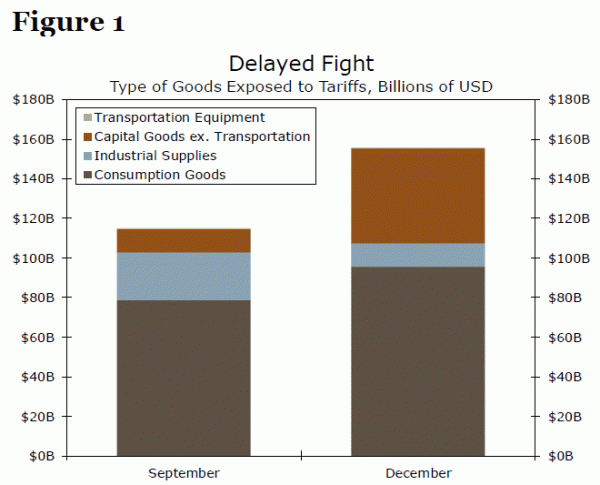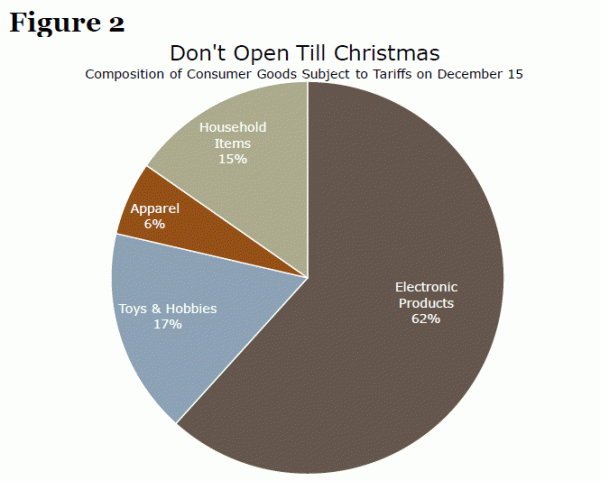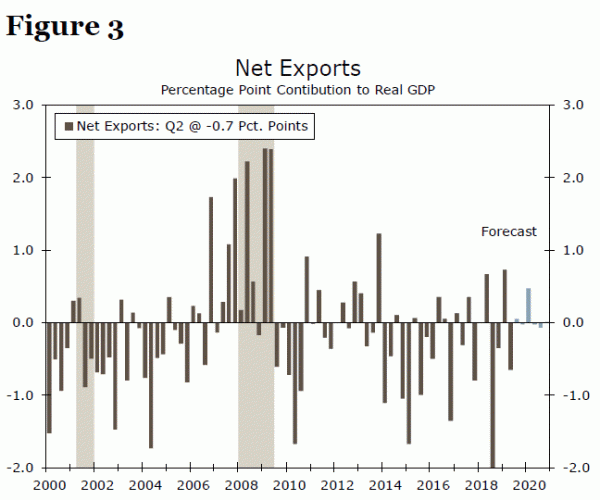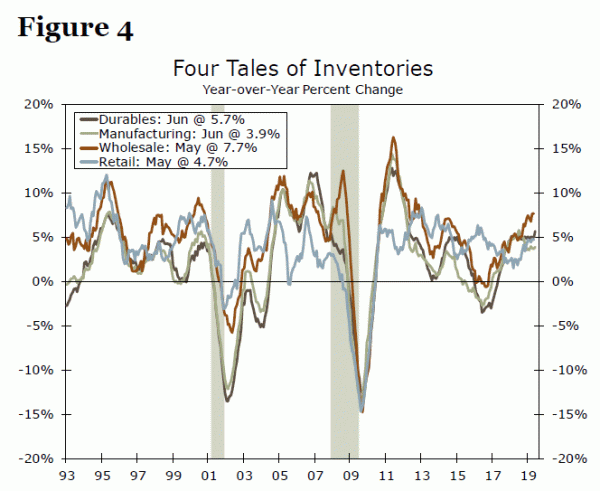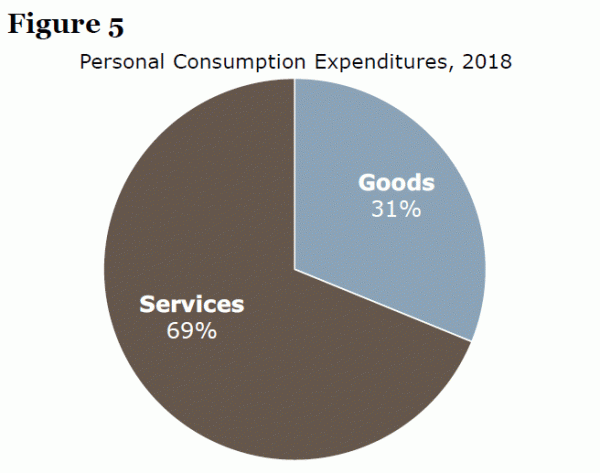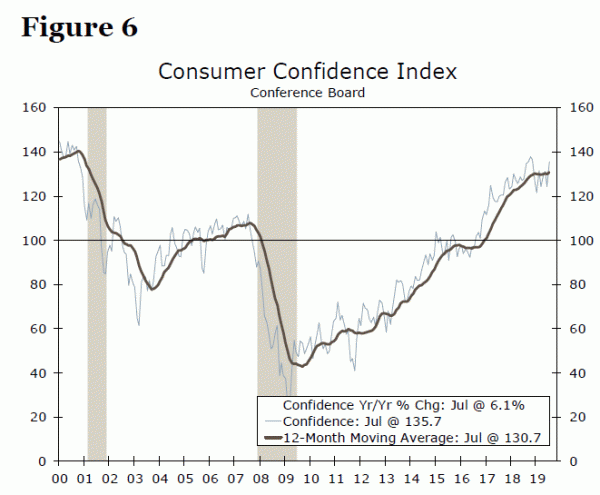Our analysis of today’s announcement of a postponement of a subset of the tariffs on imported Chinese goods suggests that about 60% of the total, or roughly $155 billion worth of goods, will be delayed. The 10% tariff on the remaining $107 billion of imports from China will still go into effect on September 1. The delay reduces the risk that trade tensions will take a meaningful toll on consumer confidence and weaken real household spending, at least in the near term.
This short report unpacks the latest developments and what they mean for the economy in the months and quarters ahead. In short: we are not going back to the drawing board for a complete re-thinking of our forecast, though the timing of trade and inventory swings could be impacted.
Unpacking the Deferral Announcement
The U.S. Office of the Trade Representative (USTR) announced the additional 10% tariff on imports from China would go forward on September 1, but acknowledged that certain goods would not be subject to tariffs until December 15. The USTR released two lists of Harmonized Tariff Schedule (HTS) codes exposed to tariffs. The first, List A, discloses items that will be subject to tariffs on the originally stated date of September 1. The second, List B, lists items that will not be subject to tariffs until December 15.
The USTR identifies products based on 8-digit HTS commodity codes, which are very specific and include over 15,000 unique categories. For this reason we focus on the broader 4-digit codes, which cover approximately 1,200 product categories. Based on our first pass at the two lists released today, we estimate the products exposed to tariffs on September 1 represent roughly 40% of this total new round of tariffs, or about $107 billion when using 2018 trade data (Figure 1). The products in List B, which are set to be under tariffs on December 15, make up about 60%, or $155 billion. If you notice, this gets us closer to $260 billion, rather than the $300 billion previously estimated by the USTR. 1
Taking our analysis a step further, based on the 4-digit HTS code detail, we grouped the exposed commodities into 4 buckets: consumption goods, industrial supplies, capital goods excluding transportation and transportation equipment. While one could reasonably come to different groupings, our approach was pretty straightforward. We grouped anything that can be directly consumed by households as consumption goods, input material/products as industrial supplies, machinery and equipment as capital goods excluding transportation and transportation equipment as just that, transportation machinery.
In a special report published last week, “Consumers Now Directly in Tariff Crossfire,” we discussed how the recent escalation would impact finished goods like toys, clothing and consumer electronics (Figure 2). Today’s announcement offers a temporary stay of execution for many of those categories.
While many retailers likely have a significant share of their holiday inventory already, the delay announced today relieves some of the pressure and perhaps offers more time for a breakthrough in trade talks which have stagnated in recent months.
The Bump to Inflation Was Already Going to Be Small
As we discussed in an earlier report, the 10% tariffs on remaining imports from China would add about 0.1% to inflation. But given that retailers would likely be loath to raise prices ahead of the allimportant holiday season, as well as the likelihood that many prices from their suppliers were already set, we did not expect to see tariffs from this tranche feed through to inflation until early next year. The delayed imposition of tariffs on the bulk of this round makes it look even more likely that the impact on inflation will not be seen until the start of next year.
Implications for Trade & Inventories
Whenever imports rise more than exports, the net result from trade is a drag on GDP growth. So the delay in the implementation of $155 billion worth of goods subject to tariffs for the duration of the fourth quarter could mean that imports now grow faster than we had previously expected.
Our latest forecast anticipated that exports and imports would both increase only modestly with no net contribution to headline growth. To the extent that we see importers rushing to bring forward demand for goods prior to the now-delayed implementation of new tariffs, we could see a modest drag from trade (Figure 3).
Inventories are apt to be impacted as well. While we cannot ascribe intent to inventory decisions, Figure 4 shows the year-over-year growth in inventories for various categories. One takeaway from this chart is that wholesale inventory growth is outpacing other categories by a greater degree than any other period in this cycle. That would be consistent with the narrative that businesses are trying to get product through customs prior to the tariffs taking hold.
What the Delay Means for Consumer Spending
While we did see scope for higher prices on consumer goods, we never held the view that those higher costs would signal a collapse in spending. As we said in our paper last week, if you add up all the money that a typical household spends on goods, it sums to only about a third of overall consumer spending (Figure 5).
Higher costs are still on the way if the December effective date holds. Once that happens it will either lead to lower sales of these consumer items, or squeeze wallet share for other spending, including services. It could also result in a lower saving rate, as consumers are only able to stretch a paycheck so far.
Although consumer confidence has come off the boil from its cycle high back in October, it has remained historically high despite headlines about the trade war (Figure 6). The delayed tariffs impact categories like apparel, footwear and toys which means that the pass-through effect to the consumer will now be less impactful during the holiday shopping season. The tariffs will therefore not have the same negative impact on confidence they might otherwise have had. While the delay does not have a noticeable bearing on our near-term outlook for spending, it postpones the risk that spending will be curtailed indirectly via lower consumer confidence.
1 While the media accounts refer to $300 billion, our accounting based on the listed HTS codes and last year’s trade with China gets us closer to $260 billion. We are primarily concerned with the share in this exercise and it clear to us that comfortably more than half of the total will be delayed until December.




